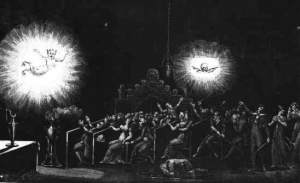[Cross-posted from my column on Anthropology News]
As I write this, magazines, newspapers and blog sites around the world proffer their predictions for 2014. Many of these are predictably banal; other prognostications are realistically pessimistic; many come from journalists, some from our social science colleagues. But they are still predictions—extrapolations from present conditions into a future that is always a continuation of the past. On the other hand, anthropology is conspicuously silent on the subject of 2014. But what would we say? Anthropological data seem utterly unsuited to annual prediction; the people and events we describe don’t fall along a linear path where the future can be neatly plotted like the price of gasoline.
And yet, it would be difficult to find a discipline more concerned with the future. The 2013 annual meeting was a case in point; stimulated by the theme “Future Publics,” a record 573 papers dropped references to the future in their paper titles or metadata. But with a couple of exceptions, these were not predictions. Instead, they were acknowledgements of precarity, admonitions that conditions were in motion, and that culture was about unexpected emergence. Perhaps this betrayed a general nervousness about our own future fates. For most of us, the university of 2014 is not looking much like the university of our undergraduate years, and one can hardly avoid some reflexivity in the 2013 theme. What would our future be?
What many of us in cultural anthropology hope is that the future will be different—that it will give us critical alternatives to the problems we see now, that it will open up different possibilities for human freedom. Yet, no 2014 predictions in journals or newspapers I’ve seen suggest much in the way of difference. In fact, they really don’t suggest any critical future at all. They are futures defined by degree: more or less unemployment, more or less consumption, more or less of the same. On the other hand, I would argue that the future work implicit in this year’s Annual Meeting is the possibility of alternative futures; the hope here, asKim Fortun has written, is “to articulate something that could not be said, could not be brought together before.”
Allow me to suggest that the appropriate metaphor for this approach to anthropological futures is “ghost anthropologies”. By this, I mean anthropology inflected by two, related technologies. First, something very much like the idea of phantasmagoria—those magic lantern shows that projected ghostly images around 19th century parlors. For Walter Benjamin, these spectral entertainments are the master symbol for the mystifications of bourgeois ideologies that suffuse reality with media and spectacle. Living with these ideological ghosts makes it difficult to interrogate the present and say something new about the future—to achieve the“critical distance” from the present . At the same time, the technology of the phantasmagoria represents the possibility for critical transformation; humans make these ghosts, after all.
This is exactly the state we are in right now with efforts to create what my co-author Matthew Durington and I are calling a “networked anthropology”. All around us social life is suffused with highly instrumental social networks upon which we commodify ourselves with our media productions. I am (literally) working for Facebook, for Google+, each time I lavish my leisure minutes embellishing their corporate sites. And yet, through these same social networking sites, we may come to realize and question our commodified connectedness in ways that may ultimately upend the logic of the neo-liberal. But what would this critical anthropology look like? Here, the future becomes murky. Can we imagine a networked ethnography that critiques social media even as it engages it? Perhaps we can only evoke it.
But the idea of evocation seems overly poetic—as if we could only artfully hint at alternatives. But I would suggest a second possibility, this one drawn from a more recent technology: “ghost imaging”—a technique that draws on quantum mechanics to describe unknown objects using entangled photons. The detectors do not see the object; instead, the entangled photons allow scientists to image the object they cannot see. That is, that object can be visible even though we have never seen it, through photons that are paired with the photons that did hit the object.
In other words, we see the ghost, but the object is real. To carry the analogy, the goal here is to describe and document social and cultural alternatives that lie outside of ideologically loaded discourse. The moment we turn to the language of Web 2.0 to describe our engagements with social media, we enter the realm of commodified user content. The future, such as it is, is already set—a linear projection off of the status quo. However, even within this society of the spectacle, there are emancipatory possibilities—even if they lie beyond the reach of our critical discourse. So we grapple with other ways of describing. But we’re still describing something; the real that we can’t articulate.
Over the course of 2014, “Ghost anthropologies” will look into other sites where these spectral investigations are taking place, where we engage both the mystifications and emancipatory potentials of phantasmagoria. That will include areas of science and technology studies, but also other possibilities, as anthropologists (and others) strive to describe the indescribable.

